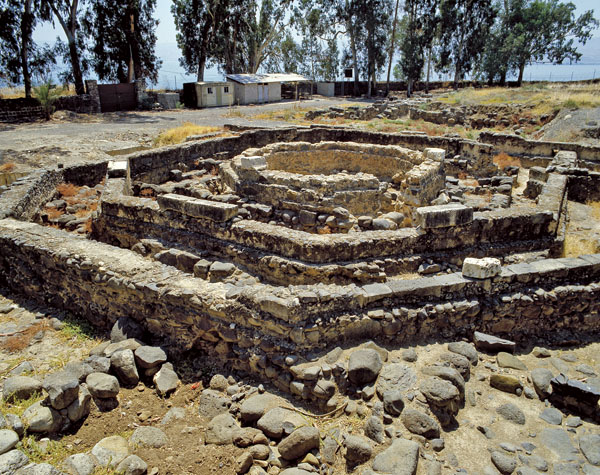
Text & Translation
29 Καὶ εὐθὺς ἐκ τῆς συναγωγῆς ἐξελθόντες ἦλθον εἰς τὴν οἰκίαν Σίμωνος καὶ Ἀνδρέου μετὰ Ἰακώβου καὶ Ἰωάννου.1
And straight away, after coming out of the synagogue, they went into the house of Simon and Andrew with James and John (Mk 1:29, AT)
- An Action-Packed “Day” in Capernaum
- Where You From?
- Honor Your Father and Mother — and Mother-in-law
- Peter’s House
- Conclusion
- Bibliography
An Action-Packed “Day” in Capernaum
Mark presents several episodes as occuring on a single day (Mk 1:21-38)2 (though technically — given how Jews reckoned “days” — the Sabbath would be over once the sun went down (and a new day would begin) (cf. Mk 1:32)).3
This is the same group of the first disciples that Jesus calls (cf. Mk 1:16-20) — Simon (Peter) and Andrew, James and John.4 This episode takes place right after the synagogue exorcism in Capernaum (Mk 1:21-28).5
There are five occurences of one of Mark’s favorite words, which I translate straight away (euthys). (cf. Mk 1:21, ESV; Mk 1:23, ESV; Mk 1:28, ESV; Mk 1:29, ESV; Mk 1:30, ESV).6 As we’ve said, this gives the fast-paced, action-packed, narrative a “sense of urgency”.7
Where You From?
Andrew and Simon (also Philip) were from the town of Bethsaida (Jn 1:44)8– not far from Capernaum.9
Simon may have been born in Bethsaida10 and moved once he married.11 Also, commercial fisherman may have had more than one domestic residence.12
Even nowadays, the questions, “Where do you live?” and “Where are you from?” can be answered with two different locations. I am from New Jersey — my place of birth — but I currently live in Pennsylvania — my place of residence.13
Similarly, Simon and Andrew’s place of birth was Bethsaida, while their place of residence was Capernaum.
Honor Your Father and Mother — and Mother-in-law
Furthermore, during this time period, many parents died when their children were still young adults. Thus, Simon and Andrew may have taken over their (deceased) parents’ home.14 We do not know for certain.
Simon’s father-in-law likely had (also?) passed away, so he took his mother-in-law in to live with him (cf. Mk 1:30).15 In ancient times, people took in and cared for their extended family more than we do in the West today.16
As we’ve said, honoring one’s parents (cf. Ex 20:12) was often seen as the most important command.
Peter’s House
Evidently, Peter (also called Cephas cf. 1 Cor 15:5) was married and even later took his wife with him during his missionary travels. Even Paul acknowledges this in 1 Corinthians:
“Don’t we have the right to take a believing wife along with us, as do the other apostles and the Lord’s brothers and Cephas? (1 Cor 9:5, NIV;17 cf. Mt 8:14, Lk 4:38).18
Clement of Alexandria (c. AD150 – c. AD 215) claimed Peter’s wife was martyred before him.19 Simon Peter was likely killed in the 60’s AD under the reign of Emperor Nero.20
In Jesus’ day, newlyweds often lived with the family of the husband (e.g., in a shack on a roof) until they had enough money to move out.21 It seems that Peter and his wife, along with Andrew and Peter’s mother-in-law, all lived under the same roof.
In 1968,22 archaeologists discovered the ruins of an eight-sided 5th/6th century Christian basilica23 built on top of a 2nd-4th century four-sided shrine with 2nd century Christian graffiti,24 built on top of “private domestic structures”.25
The location of these ruins is only 30 meters south of the location of the Capernaum synagogue.26 After leaving the synagogue, this would have been a quick trip home.
The early church believed this location to be the house of Peter.27 And, Christians likely gathered there from late 1st to early 2nd century.28
Interestingly, many relics of fishing instruments were found in and near the house.29 And, of course, before being called to be a fisher of men/people, Peter was a fisherman.
We are not certain that the house is actually Peter’s,30 but it very well could be.31
In any case, in Mark, Jesus is often “in a house” (Mk 2:1, 7:17, 9:28, 33, 10:10;32 cf. Mk 3:20, 7:24).33 This house may often be Peter’s,34 but not always (cf. Mk 9:28, 30, 33, 10:1, 10).35
While in Capernaum, Jesus may even have lived in Peter’s house.36
Here is a picture of the ruins of what may have been Peter’s house in Capernaum:
Conclusion
Immediately after leaving the Capernaum synagogue, Jesus, Simon (Peter), Andrew, James, and John go to Simon and Andrew’s house. In Mark, Jesus will often be in this house — the ruins of which may have been discovered in the late 1960’s.
For more commentary on Mark, please visit the Book Study Overview page. For the sources cited, please see the bibliography.
Sources
- Barbara Aland et al., eds., The Greek New Testament, Fifth Revised Edition (Stuttgart, Germany: Deutsche Bibelgesellschaft, 2014), Mk 1:29.
- Edwards, 58-59
- Stein, 95
- Hurtado, 28; Edwards, 59
- Schnabel, 59; Garland, 72
- Edwards, 58-59
- Edwards, 58-59
- Guelich, 62; Stein, 93; Strauss, 99
- Stein, 93
- Stein, 93
- Guelich, 62
- Guelich, 62; cf. Strauss, 99
- cf. Stein, 93 FN
- Keener, 132
- Keener, 132
- Keener, 132; Strauss, 99
- Witherington, 99; Bock, 415; Schnabel, 59; Brooks, 52; Guelich, 62; France, 107
- Stein, 94; cf. Strauss, 99
- “Clement of Alexandria, Stromata) 7.11.63, cited also in Eusebius, Church History 3.30. Stromata 3.6.52 merely indicates that Peter had a family.” Brooks, 52.
- “Therefore he most likely spent the last years of his life in Rome and there suffered martyrdom under Nero, perhaps the reverse crucifixion as tradition states.”
Walter A. Elwell and Barry J. Beitzel, “Peter, The Apostle,” Baker Encyclopedia of the Bible (Grand Rapids, MI: Baker Book House, 1988), 1667.
- Keener, 132
- Stein, 93
- Schnabel, 59 cf. Evans, 174; France, 107; Strauss, 99
- Schnabel, 59 cf. Edwards, 59; Strauss, 99.
“Although the dwelling in question underwent various developments in succeeding centuries, archaeological investigations have discovered sacred and devotional graffiti in Greek, Latin, Syriac, and Aramaic scratched on the plaster walls, indicating that it was venerated as a gathering place for Christians, and perhaps as a church, from the end of the first century or the beginning of the second.” (Edwards, 59).
- Schnabel, 59
- Schnabel, 59 cf. Lane, 77; France, 107; Strauss, 99
- Evans, 174
- Edwards, 59; cf. Strauss, 99
- Evans, 174
- Evans, 174
- Schnabel, 59; Edwards, 59; France, 107; Stein, 94; Strauss, 99
- Evans, 174; Guelich, 62
- France, 107; Stein, 93
- Evans, 174; Guelich, 62 cf. Schnabel, 59
- Stein, 93
- Edwards, 59; France, 107
- https://www.biblicalarchaeology.org/wp-content/uploads/2011/03/house-of-peter-in-capernaum.jpg

